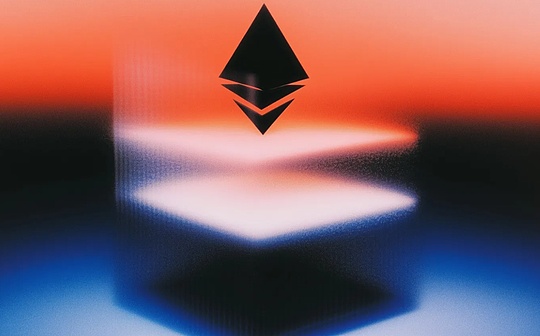
Author: On-chain highlights Source: medium
Ethereum was ten years old yesterday. When the Genesis block was launched in 2015, it was just an “experimental project”. Now it manages the value of Layer2 locked shares of over US$44 billion and is one of the infrastructures that carry global cryptocurrency ETFs. Ethereum’s first decade wrote the most magnificent evolutionary process in blockchain history. From DAO forks to mergers and upgrades, from high Gas fees to Rollup promotion, every crisis has become a stepping stone for technological leaps.
But at the beginning of the second decade, Ethereum’s “coming-common gift” is not easy. After the account is abstractly implemented, security loopholes appear and the Layer2 ecosystem has a “separation war”. MEV erodes fairness and global regulation is a “double-edged sword”. These four core problems are like the sword of Damocles hanging on their heads. Institutional funds are pouring in through ETFs and ordinary users are looking forward to a better interactive experience. Ethereum has to find a new balance between technological ideals and real compromises.
Account Abstraction: A Life-Death Game of Convenience and Security
In May 2025, a user talked about his experience on social media: after clicking authorization, the wallet balance was transferred to 15 minutes, and the other party did not even obtain his private key. When using the “One-click Upgrade Account Abstraction” function of a certain wallet, the user accidentally authorized a malicious contract, and the ETH worth 120,000 yuan was automatically transferred. This situation is not an isolated case. Blockchain security company SlowMist has counted that in just two weeks of upgrading Pectra, more than 100,000 wallets were stolen due to EIP-7702 authorization vulnerability, with a total loss of US$150 million.
The bilaterality of EIP-7702
The Pectra upgrade, which was launched on May 7, 2025, achieved a major breakthrough in “account abstraction” through EIP-7702. Ordinary user wallet (EOA) is allowed to temporarily have smart contract functions to support “Web3 native experiences” such as batch transactions, Gas fee payment, and social recovery. In theory, Ethereum has not solved the “user experience problem” that has not been solved in ten years has been solved. In the past, it took 2 authorizations and 1 transaction to complete a DeFi redemption. Now it can be merged into a single step operation, and developers can also pay Gas fees for users, making “zero ETH playable Web3” a reality.
Behind the convenience, the trust model has been completely refactored. The CertiK security team pointed out that EIP-7702 broke the underlying assumption that “EOA cannot execute contract code”. Old contracts relying on tx.origin==msg.sender are therefore at risk of reentry attacks. What’s more serious is that hackers take advantage of users’ novelty about “account abstraction” and use phishing links to induce users to authorize malicious contracts, just like the number one EIP-7702 delegation contract (0x930fcc37d6042c79211ee18a02857cb1fd7f0d0b) was found to automatically redirect funds. Novice users who are exposed to account abstraction for the first time account are 73% of the victims.
Future direction
The Ethereum Foundation is promoting the “Smart Account Security Standard”. The wallet is required to display the open source status of the delegation contract and join the 72-hour cooling-off period. However, the real challenge is to balance “flexibility” and “security”. Institutional users need complex permission management such as multi-signal plus time locks, while ordinary users want to use it as simple as Alipay. Vitalik said at the Hong Kong Web3 Carnival that account abstraction is not the end point, but the continuous game between “user sovereignty” and “security guardrail”.
Layer2 Ecology: The “Secession Crisis” Behind Prosperity
USD 0.01 on Arbitrum is enough, but the main network gets $5. Beijing developer Zhang Ming complained that it took him 30 minutes to cross-chain assets when he bought NFTs at zkSync, which reveals the current situation of Layer2: in 2025, the total locked value of Ethereum Layer2 can exceed USD 52 billion and the daily trading volume reaches 40 million, but users still have to exchange it between different Rollups as if they are in multiple parallel universes.
Optimistic Hegemony&ZK Counterattack
Currently, the Layer2 ecosystem is polarized. Arbitrum (TVL reaches US$17.8 billion) and Optimism (TVL reaches US$8.9 billion) in OptimisticRollup have become the first choice for developers due to EVM compatibility, thus accounting for 72% of the market share. ZK-Rollup’s zkSync (TVL$3.8 billion) and Starknet (TVL$2.2 billion) are catching up quickly and zero-knowledge proof technology has made it compress transaction confirmation time to 2 seconds, and the handling fee is 60% lower than OptimisticRollup.
But there are hidden worries under prosperity:
-
Liquidity Separation: Uniswap’s liquidity in Arbitrum reaches 8 times that of zkSync and can only recharge repeatedly when trading.
-
Technology fragmentation: OptimisticRollup relies on “fraud proof”, which makes withdrawals take a 7-day period, and the cost of generating proofs from ZK-Rollup is still a threshold for ordinary developers.
-
Centralized risk: Arbitrum’s sequencer (transaction sorter) is controlled by OffchainLabs and it was interrupted for 3 hours due to a server failure.
“Super Chain” Dream and Reality Resistance
The “Superchain” plan proposed by Optimism wants to connect all OptimisticRollups through the shared security layer, but the progress is not fast. By July 2025, only Base and Zora completed cross-chain interoperability, while zkSync and Starknet jointly launched the “ZK Alliance” to achieve mutual recognition, but compatibility of different ZK algorithms is still a problem. Blockchain analyst Wang Feng said that whether Layer2 ultimately looks like “a seamless network” or “multiple split small turfs” will determine whether Ethereum can host 1 billion users.
MEV: The fair dilemma of blockchain “Dark Forest”
On March 24, 2025, Uniswap user Michael wanted to exchange US$220,000 for USDC, but encountered a typical “sandwich attack”. The MEV robot first bought USDT and raised the price. After Michael’s transaction, the robot sold it immediately, which made Michael only receive 5272USDT and lost 215,000 USD. The data on the chain shows that the verifier bobTheBuilder packaged the transaction and received a “tip” of USD200,000, and the attacker only made a profit of USD8,000, and ordinary users became the biggest victim.
MEV Industrialization and Network Fairness
After Ethereum switched to PoS, MEV (maximum extractable value) changed from “miner privilege” to a professional industry. Arbitrage scripts were written by searchers and the builders were responsible for packaging transactions, while the optimal block was selected by verifiers. In the first quarter of 2025, the total withdrawal of Ethereum MEV reached US$520 million, of which DEX arbitrage and liquidation accounted for 73%, and 15%-20% of the transaction costs of ordinary users were “implicit taxes” paid for this.
What is even more serious is “MEV centralization”: 65% of the block construction rights are controlled by the top builder Flashbots. Verifiers often choose high MEV blocks in order to achieve higher returns, making it difficult for small and medium-sized builders to survive. MIT professor Muriel Médard issued a warning that if the block sorting rights are monopolized by a few institutions, Ethereum may become a “high-frequency trading amusement park on Wall Street.”
The road to breaking the deadlock: From technical defense to mechanism design
The Ethereum community is advancing several solutions:
-
Encrypted memory pool: hide transactions outside of the public memory pool so that MEV robots cannot monitor in advance.
-
MEV-Burn: Destroy some MEV earnings to reduce the validator’s rent-seeking motivation.
In Proposer-Builder Separation (PBS) mode, only validators propose blocks and builders compete for sorting rights, thereby reducing the risk of single point manipulation.But “fairness” and “efficiency” still need to be balanced in these solutions. DankradFeist, a core developer of Ethereum, said, “MEV is not a vulnerability, but an inevitable result of blockchain transparency — —Our goal is not to eliminate MEV, but to distribute the benefits to the entire network more equitably.”
Regulation and financialization: “soul-question” after institution entry
In July 2025, the Ethereum ETF approved by the US SEC had a net inflow of US$2.2 billion and the institutional holdings of ETH soared from 5% to 18%. The EU’s Smart Contract Transparency Act allowed Rollup to publicly trade algorithms and Hong Kong, China, required all crypto service providers to implement KYC. Ethereum faces the ultimate conflict between “compliance” and “decentralization”.
The “three crossroads” of global regulation
United States: The CLARITY Act will usher in a wave of Defi compliance, defining ETH as a “commodity” to allow bank custody, and DeFi platforms must also be registered as “exchanges”.EU: MiCA regulations require stablecoin issuers to hold 100% fiat currency reserves and privacy currency transactions are subject to additional approval.China: Although the mainland is still in a high-pressure situation, the cross-border settlement of digital RMB is expected to exceed 3.5 trillion yuan by 2025.As a “test field”, Hong Kong has opened up the free circulation and trading of digital assets, and the stablecoin bill has made Hong Kong’s market more vigorous.
Regulatory differences have created a series of “regulatory arbitrage”: for example, a leading DeFi protocol deploys KYC modules in the EU while Singapore retains anonymous pools. Compliance transaction pairs are the only ones that American users can access. This “fragmented compliance” not only increases developers’ costs, but also weakens Ethereum’s vision of “global unified infrastructure”.
The double-edged sword of financialization
The influx of institutional funds has given liquidity, but the correlation between Ethereum price fluctuations and U.S. stocks rose from 0.3 to 0.6; when the Federal Reserve raised interest rates by 0.5% in June 2025, ETH fell by 8% in a single day while Bitcoin was only 5%, which was unimaginable five years ago and had a more profound impact. The “value capture mechanism” has changed. In the past, ETH prices were driven by on-chain Gas fees and ecological growth, but now ETF capital flows and macro interest rates have become the dominant factors.
Xiao Feng, chairman of Wanxiang Blockchain, pointed out that in the second decade, Ethereum must find its direction between “innovating within the compliance framework” and “adhering to the original intention of decentralization”. Hong Kong may be the best experimental place. It can not only connect with the digital RMB in mainland China, but also attract global crypto companies.
Finding balance in the “Impossible Triangle”
In Ethereum’s first decade, the “merger”, “Shapella”, “Dencun” and other upgrades answered the question of “whether it can survive”, and in the second decade it had to answer “how to become a real global infrastructure”, the four major problems of account abstract security game, Layer2’s ecological integration, fair distribution of MEVs, and regulatory compliance and adaptation are essentially the continuation of the impossible triangle of “decentralization, security, and scalability”. However, this time, the trust of 1 billion users was taken as a bet.
In Ethereum’s tenth anniversary speech, Vitalik said, “We don’t need a perfect blockchain, we just need a “evolving blockchain.” In this way, perhaps the ultimate value of Ethereum is not to solve all problems, but to prove that decentralized networks can still move forward in the mutual pull of technological ideals and reality compromises.
The curtain of the second decade has been opened, and the answers will be written in every line of code, every upgrade, and every user’s wallet!







